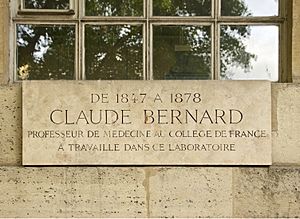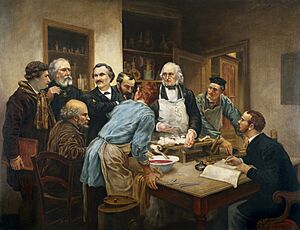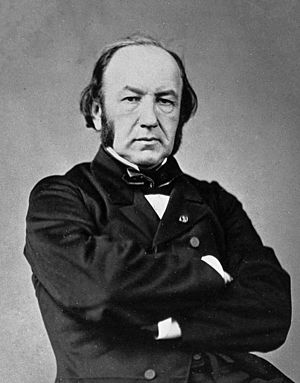Claude Bernard facts for kids
Quick facts for kids
Claude Bernard
|
|
|---|---|
 |
|
| Born | 12 July 1813 Saint-Julien, Rhône, France
|
| Died | 10 February 1878 (aged 64) Paris, France
|
| Alma mater | University of Paris |
| Known for | Milieu intérieur |
| Spouse(s) | Marie Françoise Bernard |
| Children | Two daughters, Jeanne-Henriette and Marie-Claude, and a son who died in infancy |
| Awards | Baly Medal (1869) Copley Medal (1876) |
| Scientific career | |
| Fields | Physiology |
| Institutions | Muséum national d'Histoire naturelle |
| Patrons | Louis Napoleon |
| Influences | François Magendie |
| Signature | |
Claude Bernard (born July 12, 1813 – died February 10, 1878) was a famous French scientist who studied how living things work. This field of study is called physiology. A historian from Harvard University once called Bernard "one of the greatest of all men of science." He came up with the important idea of the milieu intérieur, which is related to the concept of homeostasis. Homeostasis is about how living things keep their internal conditions stable.
Contents
Life and Early Career
Claude Bernard was born in 1813 in a small village called Saint-Julien in France. He went to school there and later to a college in Lyon. However, he soon left college to work in a pharmacy.
When he was 21, in 1834, Bernard moved to Paris. He had written a play and hoped to become a writer. But a critic told him that medicine might be a better path for him. Bernard took this advice and began studying medicine. He became an interne (a kind of resident doctor) at a hospital called Hôtel-Dieu de Paris.
At the hospital, he met a great physiologist named François Magendie. Bernard became Magendie's lab assistant in 1841. This was a key step in his scientific journey.
In 1845, Bernard married Marie Françoise "Fanny" Martin. Her family's money helped him pay for his scientific experiments. In 1847, he became Magendie's assistant professor. By 1855, he took over as the main professor.
At that time, the field of physiology was not seen as very important. Bernard's first lab was just a "regular cellar." Later, in 1864, Napoleon III, the French emperor, met Bernard. Napoleon III was impressed and helped build a proper laboratory for Bernard at the Muséum national d'Histoire naturelle in Paris. Bernard then left his teaching job at the Sorbonne to work at this new lab.
Claude Bernard was recognized for his work by many important groups. In 1868, he became a member of the Académie française, a famous French institution.
When he passed away on February 10, 1878, France honored him with a public funeral. This was a very special honor, as it was the first time such a funeral was given to a scientist. He was buried in Père Lachaise Cemetery in Paris.
Important Discoveries
Claude Bernard wanted to use the scientific method in medicine. This means using careful experiments and observations to find out how things work. He believed that living things follow the same scientific rules as non-living things.
One of Bernard's first big discoveries was about the pancreas. He showed that the juice from the pancreas is very important for digestion. This work won him a prize from the French Academy of Sciences.
Another famous discovery was about the liver and how it produces glycogen (a type of sugar). He found that the liver not only makes bile for digestion but also creates sugar from the blood passing through it. This discovery helped scientists understand more about conditions like diabetes mellitus.
Bernard also discovered the vasomotor system. In 1851, he was studying how cutting certain nerves affected body temperature. He noticed that cutting a specific nerve made blood flow more actively in parts of the head. A few months later, he found that sending electricity through the same nerve had the opposite effect. This showed him that there are nerves that can make blood vessels wider (vasodilator) and narrower (vasoconstrictor).
He was also very interested in how poisons affect the body. He studied poisons like curare and carbon monoxide gas. Bernard is known for describing how carbon monoxide affects hemoglobin in the blood.
The Milieu Intérieur
One of Claude Bernard's most important ideas is the milieu intérieur, which means "internal environment." He said, "The stability of the internal environment is the condition for the free and independent life." This means that for living things to stay healthy and alive, their internal conditions (like temperature, salt levels, and sugar levels) must stay stable, even if the outside world changes. This idea is the basis for what we now call homeostasis.
Animal Experiments
Claude Bernard made many of his scientific discoveries by doing experiments on animals. This method is called vivisection. At the time, it was a common way to learn about how living bodies work. Bernard believed that these experiments were necessary to uncover the secrets of life. He wrote that a scientist must focus on their idea and the organisms, even if it means not noticing the animals' pain.
While his experiments led to important knowledge, the practice of vivisection was, and still is, very controversial.
How Science Works: Bernard's Ideas
In 1865, Claude Bernard wrote an important book called An Introduction to the Study of Experimental Medicine. In this book, he explained his ideas about the scientific method and what makes a good scientist.
Known and Unknown. Bernard believed that a great scientist is someone who explores the unknown. When facts are already known, all scientists are pretty much equal. But true greatness comes from new ideas that explain things we didn't understand before.
Observation is Key. He stressed that science moves forward through experiments, not by just accepting what famous people or old books say. For Bernard, what we can observe and test in reality is the only real authority. He famously said:
- When we meet a fact which contradicts a prevailing theory, we must accept the fact and abandon the theory, even when the theory is supported by great names and generally accepted.
The Cycle of Science. Science is a constant back-and-forth between ideas (theories) and facts (experiments). We use facts to build general theories, and then we use those theories to predict new facts that we can test with experiments. These experiments might then lead to new theories.
Finding Causes. Scientists try to find out what causes what. For example, they want to know what causes a certain natural event. We make guesses (hypotheses) about cause and effect. Then we test these guesses. If a guess is proven true, it becomes a scientific theory.
Testing Theories. Bernard explained that theories are just guesses that have been tested with many facts. The more facts that support a theory, the better it is. But even the best theories are never final. We should always try to prove our own theories wrong with new experiments. If an experiment shows your idea is wrong, you must accept it, as long as the experiment is proven correct.
Truth and Discovery. Bernard believed that a true scientist has a strong desire for truth and a "thirst for the unknown." They are always trying to discover new things, even if it means changing their own ideas. He said that great minds are never satisfied; they keep striving.
He also warned about scientists who try to hide facts that don't fit their theories. He called them "despisers of their fellows" because they try to make others' theories look bad and only report results that support their own ideas. This, he said, "falsifies science and the facts."
Bernard believed that the progress of science would never be stopped by such people. The "ardent desire for knowledge" will always drive true scientists forward. Even if they don't find all the answers, they discover important pieces of the truth, and these pieces make up science.
Images for kids
See also
 In Spanish: Claude Bernard para niños
In Spanish: Claude Bernard para niños





